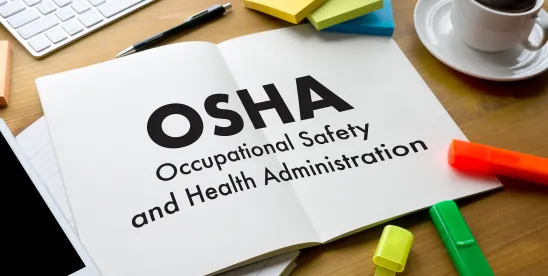The Occupational Safety and Health Administration (OSHA) has proposed to update its long-standing emergency response requirements, and stakeholders still have an opportunity to provide their input to OSHA. OSHA published a proposed rule in February, 89 Fed. Reg. 7774 (Feb. 5, 2024), which would replace the 40-year-old Fire Brigades Standard and make notable changes to some other standards. OSHA has extended the comment period until July 22, 2024, so there is still time to comment on the proposal.
Current Fire Brigades Standard
The current Fire Brigades Standard, 29 C.F.R. § 1910.156, promulgated in 1980, focuses on fire brigades, industrial fire departments, and private or contractual type fire departments. Specifically, it outlines organization, training, and personal protective equipment requirements. In contrast, the proposed rule would address a wider range of hazards; reflect changes and improvements to protective clothing, equipment, and safety and health practices; and align with industry consensus standards issued by the National Fire Protection Association (NFPA).
Scope of the Proposed Rule
The proposed rule’s scope substantially expands beyond firefighting services to include private employers who provide other emergency services, such as pre-hospital EMS and technical search and rescue services. Public and municipal fire departments in states with OSHA-approved State Plans would also be affected. The new standard would introduce two categories of emergency response employers:
- Workplace Emergency Response Employers (WEREs): Employers engaged in manufacturing, processing, and warehousing with a workplace emergency response team that responds to emergency incidents, such as firefighting, emergency medical services, and technical search and rescue, in addition to their daily work. Many industrial establishments may qualify as WEREs.
- Emergency Service Organizations (ESOs): Employers whose primary function (or whose employees’ primary function) involves providing services such as firefighting, emergency medical service, and technical search and rescue. ESOs are primarily likely to be dedicated emergency responders, such as local fire departments.
While the proposed rule would not apply to “true volunteers,” it would extend to volunteers who receive “significant remuneration,” as they are considered employees under federal law. In states with OSHA-approved State Plans, however, a volunteer may be treated as an employee under relevant state law.
The proposed rule would follow an all-hazards approach, aiming to protect emergency responders against all forms of emergencies. However, the proposed standard outlines specific exclusions. It would exclude employers involved in disaster site clean-up and recovery duties after the conclusion of emergency response activities. Moreover, it would not apply to activities covered by 29 C.F.R. § 1910.120 (Hazardous Waste Operations and Emergency Response (HAZWOPER)) and 29 C.F.R. § 1910.146 (Permit-Required Confined Spaces). Instead, it would make limited changes to HAZWOPER itself.
Key Elements of the Proposed Rule
HAZWOPER
The proposed changes to HAZWOPER are minimal. One update would change HAZWOPER’s cross-reference to personal protective equipment requirements to align with the new rule. Additionally, the proposed rule would revise Appendix B to § 1910.120, replacing three outdated NFPA standards related to personal protective equipment. Instead, it would incorporate by reference the current NFPA standard, which sets requirements for ensembles used by emergency responders during hazardous materials emergencies and CBRN (chemical, biological, radiological, and nuclear) terrorism incidents.
NFPA Standards
In total, the proposed rule would incorporate 22 NFPA standards by reference. OSHA believes that most WEREs and ESOs currently adhering to these standards already closely or completely comply with many provisions of the proposed rule, as, according to OSHA, the NFPA standards are generally regarded as industry best practices. While a few standards would apply only to ESOs, a large number would be applicable to WEREs. Those standards would thus be legally enforceable against industrial establishments covered by the proposed rule. Among other things, covered employers would have to meet:
- Job performance requirements for driving and operating fire apparatus; marine firefighting for land-based firefighters; technical rescue operations; fire officer duties; fire brigade operations; and emergency vehicle technicians.
- Training requirements for fire service personnel to perform rapid intervention operations to rescue firefighters.
- Various protective clothing, equipment, and ensemble requirements for technical rescue; surface water operations; contaminated water dive operations; structural and proximity firefighting; wildland firefighting; wildland-urban interface firefighting; and emergency medical operations.
- Requirements for establishing an inspection, maintenance, refurbishment, retirement, and testing program for emergency service vehicles and marine firefighting vessels.
- Other personal protective equipment requirements for self-contained breathing apparatus (SCBA); personal alert safety systems (PASS); respirators for wildland firefighting operations and wildland urban interface operations; respiratory equipment for tactical and technical operations; combination unit respirator systems for tactical and technical operations.
Other Requirements
Notably, ESOs would be subject to more stringent requirements under the proposed standard compared to WEREs. This is because emergency response duties are merely collateral to WEREs’ primary work responsibilities, reducing exposure to related hazards.
Covered employers would be subject to several written requirements. WEREs and ESOs would have to:
- Prepare an emergency response program (ERP) to ensure the employer is prepared to safely respond to and operate in emergency and non-emergency situations and to provide for the occupational safety and health of team members and responders. Employers would have to share a central plan containing emergency procedures with supervisors and employers. Further, WEREs would have to establish the existence and organizational structure of a Workplace Emergency Response Team (WERT).
- Create a risk management plan containing a control plan to reduce risks as low as reasonably practicable. At a minimum, the plan would have to cover risks to team members and responders; training; vehicle operations (both emergency and non-emergency); operations at emergency incidents; non-emergency services and activities; and activities that lead to exposure to combustion products, carcinogens, and other incident-related health hazards. WEREs and ESO would still have to address all reasonably anticipated hazards even if some are not covered by the minimum requirements.
- Establish pre-incident plans (PIPs) containing information to assist the employer in preparing for emergencies and aid in decision-making during the incident. WEREs specifically would have to create a PIP for locations within the facility where team members may be called to provide service as determined by a facility and vulnerability assessment. PIPs would also have to include the locations of unusual hazards, fire suppression systems, and smoke control and evacuation systems.
- Establish standard operating procedures (SOPs) for emergency events the employer is reasonably likely to encounter, including situations involving unusual hazards, incidents beyond their capabilities, and contaminants and decontamination of team members. This determination would be based on factors such as the types and levels of services and community or facility vulnerability assessments. It would also establish protocols for vehicle operations, radio communication and terminology, operations at potentially unsafe locations, evacuation, Mayday situations, and medical monitoring.
- Create an incident management system (IMS) that would establish functions for managing incidents, describe the roles and responsibilities to be assumed by team members and responders, and standard operating procedures to be utilized. The IMS would have to adapt to different situations, provide for clear communication and collaboration, and indicate the incident commander’s responsibilities and minimum training requirements.
Under the proposed rule’s medical and physical requirements covered employers would have to:
- Establish requirements based on the duties performed (i.e., establish more stringent requirements for team members and responders who perform more physically demanding work or are exposed to more hazards).
- Maintain confidential records for each team member and responder, including duty restrictions based on medical evaluations; occupational illnesses and injuries; and exposures to combustion products, known or suspected toxic substances, infectious diseases, and other dangerous substances.
- Provide medical evaluations at no cost to the team member or responder to determine fitness for duty at the time of initial assignment and at least every two years. The evaluation would have to include medical and work history, a physical examination, and an assessment of heart disease.
- Offer behavioral wellness recourses at no cost to the team member or responder to address mental health issues and psychological stressors associated with the job.
With respect to training requirements, covered employers would have to:
- Establish minimum training requirements based on the type of duty performed.
- Ensure each team member or responder receives training in the beginning and throughout their employment. New team members or responders cannot perform a given duty until they have demonstrated to a supervisor or trainer that they can safely execute those responsibilities.
- Ensure trainers and instructors possess the necessary skills to teach trainees effectively. Training would have to be delivered in a language and at a literacy level that employees can comprehend. Additionally, instructors would be required to account for social context and cultural appropriateness.
- Provide training on the use of personal protective equipment and portable fire extinguishers.
- Provide training for safe exit, evacuation, and life-saving intervention protocols.
- Ensure all team members and responders comply with 29 C.F.R. § 1910.120(q)(6)(i) (HAZWOPER), which establishes training requirements for employees who may encounter hazardous materials. This would extend the requirement from hazmat teams to other team members and responders, as they are typically the first to arrive at such scenes.
- Perform annual skills checks.
Finally, the proposed rule would adopt several facility preparedness requirements. WEREs specifically would have to:
- Comply with 29 C.F.R. Part 1910, Subpart E (Exit Routes and Emergency Planning) and 29 C.F.R. Part 1910, Subpart L (Fire Protection), which requires fire detection, alarm, and notification systems maintenance.
- Provide facilities for decontaminating, disinfecting, cleaning, and storing equipment.
- Ensure fire hose connections and fittings are compatible with ESOs in the event an ESO provides the WERE with support.
Comments
At this time, OSHA has posted 192 comments on the proposal, reflecting a high level of stakeholder concerns.
The original comment deadline was May 6. However, OSHA published a Federal Register notice on March 28 extending that deadline to June 21. OSHA has now published an extension of the comment period until July 22, 2024, 89 Fed. Reg. 49119 (June 11, 2024), to give stakeholders additional time. Commenters might want to consider the following issues:
- Should OSHA consider alternative compliance dates, given the substantial scope of the proposed rule and the numerous requirements it introduces?
- How would the new rule build on, coexist with, or supplant existing OSHA standards related to emergency response?
- What administrative burdens will the various new requirements and their associated review cycles pose?
- How can incorporating several NFPA standards by reference and making those standards enforceable by law pose compliance, feasibility, and administrative burdens?






 />i
/>i

